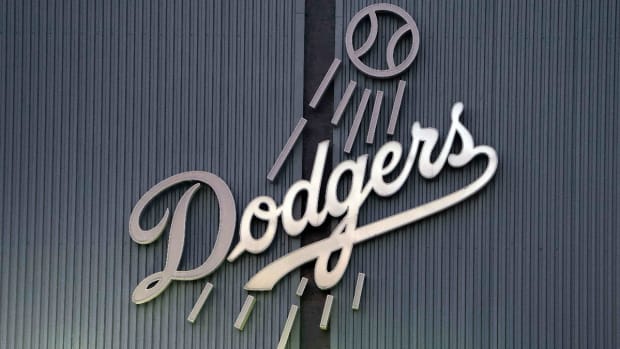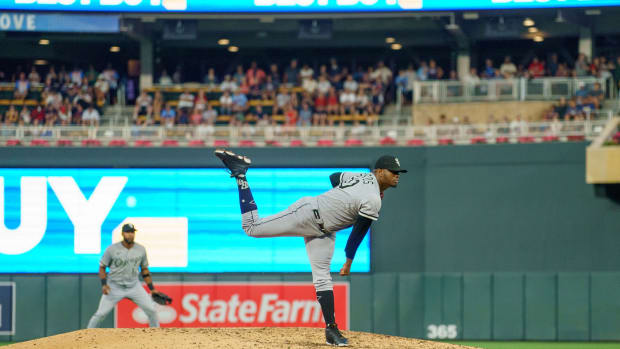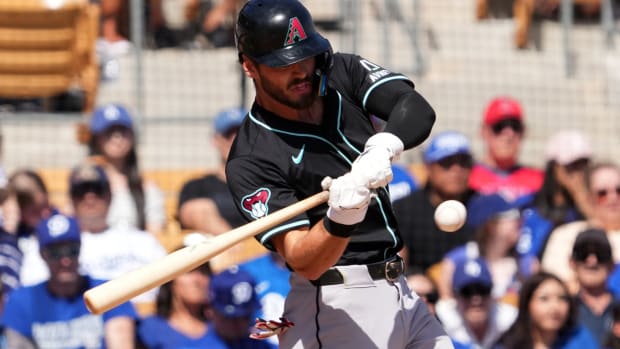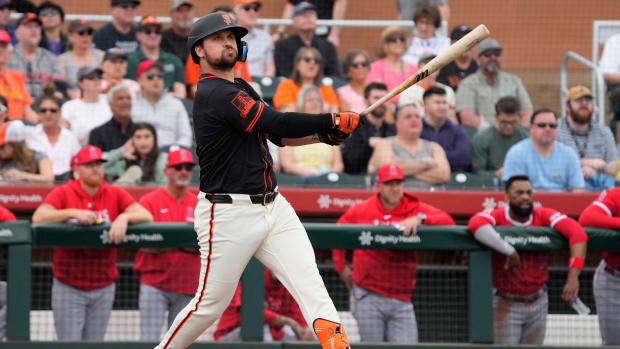Unbelievable May suggests Bryce Harper's breakout has finally begun
Bryce Harper didn't homer on Thursday, but that’s only because the Nationals weren't scheduled to play. More often than not lately, he's hit one out, and as his torrid May comes to a close, it's worth putting his month, and his season to date, in perspective.
Harper has homered in his last two games, six times in his last 11 games and 13—as many as he hit all of last season—in his last 19. That binge has run his season total to 18, tied with Nelson Cruz for the majors' highest total. Here's his most recent shot, off Jon Lester and over the ivy at Wrigley Field on Wednesday:
Tales of Todd Frazier: Reds star emerges as a baseball folk hero
With three games to go in in Cincinnati's Great American Ballpark this weekend, Harper's 13-homer May is already a club record for any month, surpassing Alfonso Soriano's 12 back in May 2006. It's as many homers as the entire Phillies team has hit this month, and three more than that of the Braves. As home run benders in May go, he's still three shy of Edwin Encarnacion's outburst last year, though he is tied with Cruz's total from the same month. Twenty-two players have hit at least 13 homers in the month of May, with 12 finishing at exactly that total. Six players put up 15, and two others besides Encarnacion tallied 16: Mickey Mantle in 1956 and Mark McGwire in '98. The record for the month is held by Barry Bonds, with 17 during his 73-homer '01 season.
• JAFFE: Why A-Rod's new AL RBI record deserves an asterisk
Harper is in more rarefied air when it comes to slugging percentage for the month, with the highest seen in 14 years. Using a cutoff of 100 plate appearances:
rk. | player | team | year | hr | avg | obp | slg |
1 | Barry Bonds | 2001 | 17 | .369 | .547 | 1.036 | |
2 | Babe Ruth | 1928 | 15 | .414 | .547 | 1.000 | |
3 | Todd Helton | 2000 | 11 | .512 | .588 | 1.000 | |
4 | Frank Thomas | 1994 | 12 | .452 | .593 | .988 | |
5 | Bryce Harper | Nationals | 2015 | 13 | .375 | .500 | .938 |
6 | Mark McGwire | 1998 | 16 | .326 | .513 | .907 | |
7 | Bing Miller | 1922 | 12 | .432 | .476 | .895 | |
8 | Jimmie Foxx | A's | 1932 | 13 | .429 | .517 | .888 |
9 | Mickey Mantle | Yankees | 1956 | 16 | .414 | .507 | .879 |
10 | Babe Ruth | Yankees | 1930 | 13 | .383 | .540 | .872 |
That's good company, with Miller likely the only unfamiliar name. An outfielder for four American League teams from 1921 to '36, he was in his second major league season when he broke out with a 12-homer month; he finished the year with a fine .335/.371/.551 line but "only" 21 homers and never hit more than 12 in an entire season again, reaching double digits just twice. As for Cruz (.339/.388/.748) and Encarnacion (.281/.369/.763), neither of them could touch Harper's May in terms of rate stats despite their home run tallies.
As impressive as it may be, Harper's .500 on-base percentage is only tied for 69th since 1914 (as far back as the monthly splits go), even taking a back seat to Jason Kipnis's .532 this month, and ranking "only" sixth in the last 10 years. More impressively, his 1.438 OPS is fourth since May 1993—third if put into context relative to the league:
rank | player | year | pa | avg/obp/slg | OPS+ |
1 | Barry Bonds | 2001 | 117 | .369/.547/1.036 | 310 |
2 | Frank Thomas | 1994 | 118 | .452/.593/.988 | 308 |
3 | Bryce Harper | 2015 | 100 | .375/.500/.938 | 293 |
4 | Todd Helton | 2000 | 102 | .512/.588/1.000 | 291 |
5 | Lance Berkman | 2008 | 123 | .471/.553/.856 | 278 |
6 | Mark McGwire | 1998 | 119 | .326/.513/.907 | 267 |
7 | Frank Thomas | 1997 | 117 | .430/.556/.814 | 261 |
8 | Jason Kipnis | 2015 | 128 | .449/.532/.738 | 253 |
9 | Bobby Abreu | 2005 | 127 | .396/.535/.792 | 252 |
10 | 2011 | 105 | .360/.476/.791 | 252 |
Overall, Harper is hitting .331/.470/.745 in 200 plate appearances, with his on-base and slugging percentages, runs (41), RBIs (43), walks (42), total bases (117), OPS+ (227) and WAR (4.3) all leading the league. He won't maintain that blistering pace, but supposing that he did while continuing to play in every Nationals game, he'd finish the season with 62 homers, 148 RBIs, 145 walks, 403 total bases and 14.8 WAR. If you're wondering what the single-season records are for players up through their age-22 seasons, Eddie Mathews's 47 homers (1953, at age 21), Joe DiMaggio's 167 RBIs and 418 total bases (both 1937), Ted Williams's 147 walks (1941, the year he hit .406) and Mike Trout's 10.8 WAR (2012, at age 20) are the marks to beat.
For Rangers, Josh Hamilton a bargain that was impossible to see coming
With a little over four months to go this year, Harper has 73 career home runs, leaving him 21st in terms of total homers through an age-22 season. If he hits 14 more homers this year, he would tie Ken Griffey Jr. and Johnny Bench for 10th on that list; if he adds another 25, he'd tie Trout and Frank Robinson for fifth. If he were actually to maintain that 62-homer pace—not likely, but I'm just spitballing here—he would run his total to 117, surpassing the age-22 record held by Mel Ott (115). In terms of where the upper echelon of the all-time home run list was through age 22: Bonds had hit 41 of his 762, Hank Aaron 66 of 755, Ruth nine of 714 (he had yet to dabble in the outfield, though he would begin doing so the next season), Alex Rodriguez 106 of 665, Willie Mays 24 of 660, Griffey 87 of 630, Jim Thome 10 of 612, Sammy Sosa 29 of 609, Robinson 98 of 586 and McGwire three of 583.
What's gotten into Harper? Primarily good health. Recall that he was hampered by left knee problems for most of 2013 after running into a wall at Dodger Stadium, missing five weeks from late May to early July and undergoing surgery to correct bursitis after the season. He started the '14 season relatively slowly (.289/.352/.422 with one homer) before tearing a ligament in his thumb on a slide in late April and missing just over two months. With neither his hands nor his legs at 100%, those injuries help explain his dip to a .273/.344/.423 line with 13 homers last year. Earlier this month, in the wake of his six-homers-in-three-days jag that kicked off this run, he told the Washington Post's James Wagner:
“This is what I was like in high school and college…That’s what people don’t understand. I was healthy. Staying healthy is what I need to do. This is the type of player I need to be and the type of player I want to be. Everybody talks about how I’m doing this different or I’m doing that different. There’s nothing different. It’s staying healthy and staying in the lineup. Truly.
…“I know it is way different here than in college and high school but if you look at all the stats I had in college and high school, they were absurd because I was in the lineup every single day. I played every day. I played year-round. I had the reps, I had the stuff, and I was never hurt. I was never hurt at all.”
…“I feel like the approach, the plan, it’s always been there. But I’m finally sticking to it because I’m not getting hurt and staying healthy."
While health is an easy explanation, it's also true that Harper has gotten more disciplined at the plate. His NL-high 4.36 pitches per plate appearance is well ahead of the 3.89 he averaged from 2012–14, never deviating by more than 0.05 per season. Beyond that, you can see it in his PITCHf/x plate discipline stats, via FanGraphs:
period | o-sw% | z-Sw% | swing% | o-ct% | z-Ct% | contact% | zone% |
2012–14 | 32.4 | 72.3 | 49.6 | 58.7 | 85.6 | 75.6 | 43.2 |
2015 | 28.5 | 67.8 | 44.0 | 63.3 | 86.5 | 77.4 | 39.6 |
(O-SW% and Z-SW% are the percentages of pitches he swings at outside and inside the strike zone, respectively; Swing% is the percentage of pitches he swings at regardless of location; O-CT% and Z-CT% are the percentages of pitches he makes contact with outside and inside the strike zone, respectively; Contact% is the percentage of pitches he makes contact with regardless of location; and Zone% is the percentage of all pitches he sees that are in the strike zone.)
Awards Watch: Pederson leading Bryant in NL Rookie of the Year race
Harper is seeing fewer pitches in the strike zone, understandably. He's swinging with significantly less frequency at pitches both inside and outside the zone, but he's making more contact when he does. And when those balls are in the air, look out. Via Bill Petti's interactive spray chart tool, whereas Harper's 251 flyballs prior to this year averaged 281 feet, with an expected run value of 11.9 per 100, this year's 22 flies (small sample, sure) are averaging 310 feet—29 feet further—with an expected run value of 57.2 per 100. Throw in his line drives, and he goes from 491 balls averaging 262.8 feet with a yield of 24.7 runs per 100 prior to this year, to 52 balls averaging 288.2 feet with a yield of 57.9 runs, again a substantial increase in distance and run value.
Any way you slice it, it's been not only a remarkable May for Harper, but a remarkable season to date. I can hardly wait to see what's next.


































